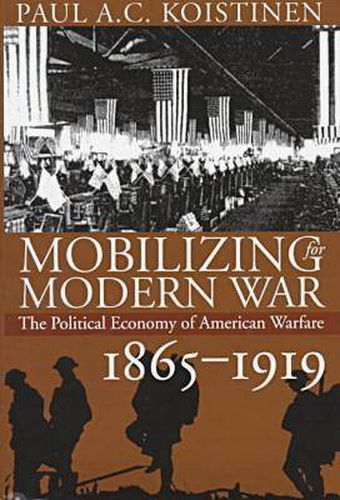Readings Newsletter
Become a Readings Member to make your shopping experience even easier.
Sign in or sign up for free!
You’re not far away from qualifying for FREE standard shipping within Australia
You’ve qualified for FREE standard shipping within Australia
The cart is loading…






This title is printed to order. This book may have been self-published. If so, we cannot guarantee the quality of the content. In the main most books will have gone through the editing process however some may not. We therefore suggest that you be aware of this before ordering this book. If in doubt check either the author or publisher’s details as we are unable to accept any returns unless they are faulty. Please contact us if you have any questions.
Although the military-industrial complex became familiar to most Americans during the Cold War, Paul Koistinen shows that its origins actually go back to the dawn of this century.
Mobilizing for Modern War , the second of a five-volume study on the political economy of American warfare, highlights the emergence of this pivotal relationship. In this volume, Koistinen examines war planning and mobilizing in an era of rapid industrialization and reveals how economic mobilization for defence and war is shaped at the national level by the interaction of political, economic and military institutions and by increasingly powerful and expensive weaponry. Covering the Guilded Age and Progressive Era through the Spanish-American War and World War I,
Mobilizing for Modern War
shows how a partnership evolved between government and business to prepare for and conduct modern warfare. This partnership was an extension of Progressive regulatory reforms, but it had to include a professionalized army and navy in order to handle the new technology of war. Koistinen traces the origins of the military-industrial complex to the emergence of a modern navy at the turn of the century, when building a new fleet of steel, armour and ordnance required a production team of political leaders, naval officers and businessmen. A similar team was brought together again between 1915 and 1918 as the War Industries Board to mobilize the economy for World War I, and it became the model for subsequent industrial mobilization planning. Koistinen shows how mobilizing for World War I left an indelible imprint on 20th-century life. By accelerating the emerging Progressive political economy, it strengthened the cooperative planning ethic within business and government and introduced the concept of industrial preparedness, carried out largely under military leadership. Relating events of this period to what preceded and followed, Koistinen argues that in this century warfare has shaped the nation’s social institutions and ideology even more than reform.
$9.00 standard shipping within Australia
FREE standard shipping within Australia for orders over $100.00
Express & International shipping calculated at checkout
This title is printed to order. This book may have been self-published. If so, we cannot guarantee the quality of the content. In the main most books will have gone through the editing process however some may not. We therefore suggest that you be aware of this before ordering this book. If in doubt check either the author or publisher’s details as we are unable to accept any returns unless they are faulty. Please contact us if you have any questions.
Although the military-industrial complex became familiar to most Americans during the Cold War, Paul Koistinen shows that its origins actually go back to the dawn of this century.
Mobilizing for Modern War , the second of a five-volume study on the political economy of American warfare, highlights the emergence of this pivotal relationship. In this volume, Koistinen examines war planning and mobilizing in an era of rapid industrialization and reveals how economic mobilization for defence and war is shaped at the national level by the interaction of political, economic and military institutions and by increasingly powerful and expensive weaponry. Covering the Guilded Age and Progressive Era through the Spanish-American War and World War I,
Mobilizing for Modern War
shows how a partnership evolved between government and business to prepare for and conduct modern warfare. This partnership was an extension of Progressive regulatory reforms, but it had to include a professionalized army and navy in order to handle the new technology of war. Koistinen traces the origins of the military-industrial complex to the emergence of a modern navy at the turn of the century, when building a new fleet of steel, armour and ordnance required a production team of political leaders, naval officers and businessmen. A similar team was brought together again between 1915 and 1918 as the War Industries Board to mobilize the economy for World War I, and it became the model for subsequent industrial mobilization planning. Koistinen shows how mobilizing for World War I left an indelible imprint on 20th-century life. By accelerating the emerging Progressive political economy, it strengthened the cooperative planning ethic within business and government and introduced the concept of industrial preparedness, carried out largely under military leadership. Relating events of this period to what preceded and followed, Koistinen argues that in this century warfare has shaped the nation’s social institutions and ideology even more than reform.